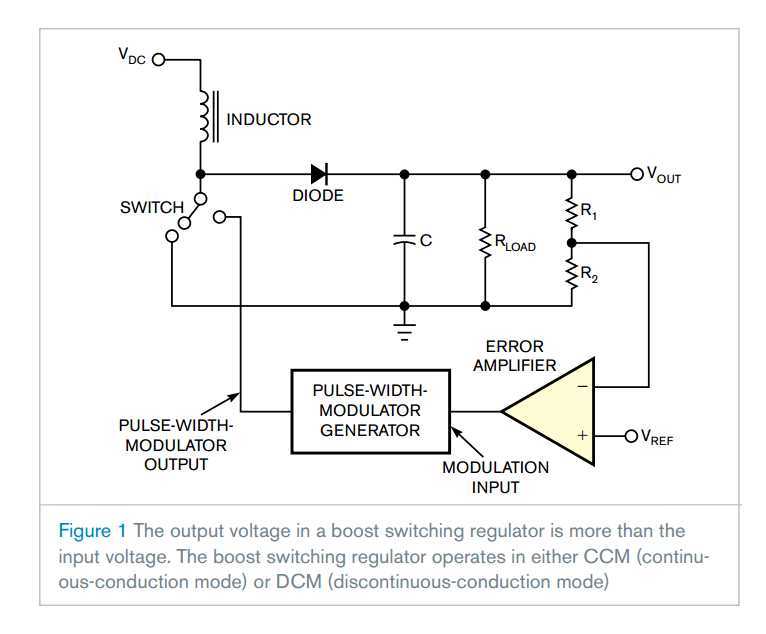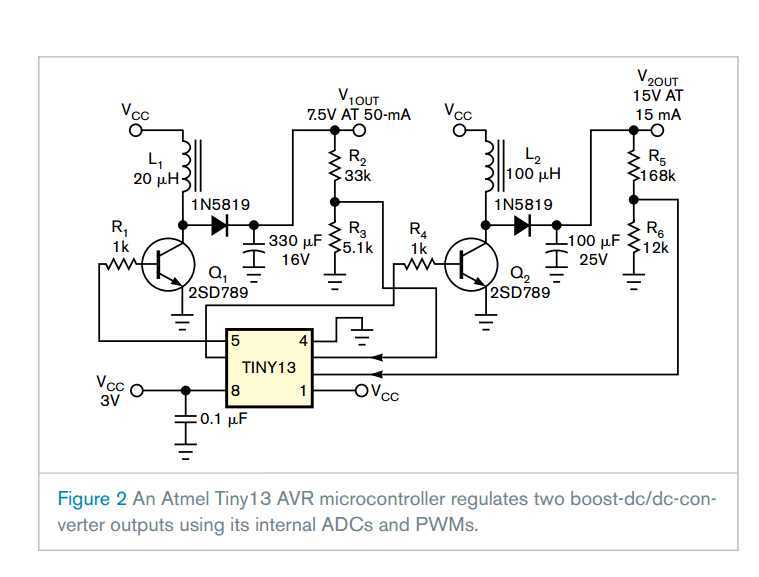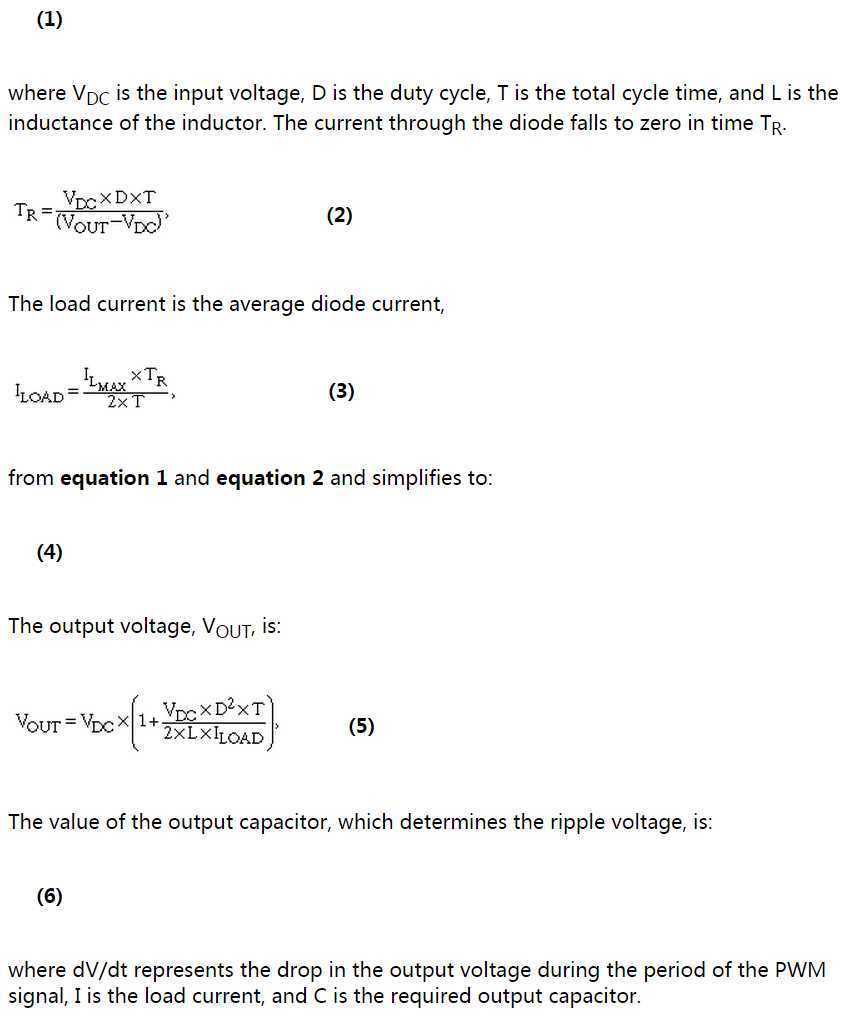标签:des style blog http io ar color os sp
Batteries are the typical power sources for portable-system applications, and it is not unusual these days to find microcontroller-based portable systems. A variety of microcontrollers operates at low power-supply voltages, such as 1.8V. Thus you can employ two AA or AAA cells to power the circuit. However, if the circuit requires higher voltage—for LED backlighting for an LCD, for example, which requires approximately 7.5V dc—you must employ a suitable dc/dc converter to boost the power-supply voltage from, for example, 3V to the required voltage. However, you can also employ a microcontroller to develop a suitable dc/dc-boost-voltage converter (Reference 1) with the help of a few additional discrete components.


This Design Idea shows how to create not just one, but two dc/dc converters with just a tiny eight-pin microcontroller and a few discrete components. The design is scalable, and you can adapt it for a wide range of output-voltage requirements just by changing the control software for the microcontroller. You can even program the microcontroller to generate any required output-voltage start-up rate. Figure 1 shows the basic topology of a boost switching regulator. The output voltage in such a regulator is more than the input voltage. The boost switching regulator operates in either CCM (continuous-conduction mode) or DCM (discontinuous-conduction mode). It is easier to set up a circuit for DCM operation (Reference 2). The name comes from the fact that the inductor current falls to 0A for some time during each PWM period in DCM; in CCM, the inductor current is never 0A. The maximum current passes through the inductor at the end of high period of the PWM output (when the switch is on) and is:

The total period of the PWM wave is T and is a system constant. D is the duty cycle of the PWM wave, and TR is the time during which the diode conducts. At the end of TR, the diode current falls to 0A. The period of the wave is T>D×T+TR for DCM. The difference of the PWM period, T, and (D×T+TR) is the dead time.
The switch that operates the inductor is usually a BJT (bipolar-junction transistor) or a MOSFET. A MOSFET is preferable because of its ability to handle large current, better efficiency, and higher switching speed. However, at low voltages, a suitable MOSFET with low enough gate-to-source threshold voltage is hard to find and can be expensive. So, this design uses a BJT (Figure 2).
Microcontrollers offer PWM frequencies of 10 kHz to more than 200 kHz. A high PWM frequency is desirable because it leads to a lower inductor value, which translates to a small inductor. The Tiny13 AVR microcontroller from Atmel has a “fast” PWM mode with a frequency of approximately 37.5 kHz and a resolution of 8 bits. A higher PWM resolution offers the ability to more closely track the desired output voltage. The maximum inductor current from Equation 1 is 0.81A for a 20-µH inductor. The transistor that switches the inductor should have a maximum collector current greater than this value. A 2SD789 NPN transistor has a 1A collector-current limit, so it is suitable for this dc/dc converter. The maximum load current achievable with these values, from Equation 4, is 54 mA and thus meets the requirement of maximum required load current for an output voltage of 7.5V.
The Tiny13 microcontroller boasts two high-speed PWM channels and four 10-bit ADC channels. Another PWM channel and an ADC channel create the second dc/dc converter for an output voltage of 15V and a maximum load current of 15 mA. The inductor for this converter has a value of 100 µH. To calculate the output-capacitor value, use Equation 6. For a 5-mV ripple, the value of the capacitor for 7.5V output voltage is 270 µF, because the output current is 50 mA and the PWM-time period is 27 µsec, so this circuit uses the nearest larger value of 330 µF. Similarly, for the 15V output voltage, the required capacitor value is 81 µF, so the design uses a 100-µF capacitor.
The programs for the microcontroller are in C and use the open-source AVR GCC compiler. The AVR Tiny13 microcontroller operates at an internal clock frequency of 9.6 MHz without an internal-clock-frequency divider, so the PWM frequency is 9.6 MHz/256=37.5 kHz. The internal reference voltage is 1.1V. The main program alternately reads two channels of ADCs that monitor the output voltages in an interrupt subroutine. The main program executes an endless loop, monitoring the output voltage by reading the ADC values and adjusting the PWM values accordingly.
1 #include<avr/interrupt.h> 2 #include<avr/io.h> 3 4 5 #define vref 931 // 931 is 1V for a 1.1 internal reference 6 #define MAX_A 70 7 #define MAX_B 128 8 9 volatile unsigned int adc_val[2]; 10 11 SIGNAL (SIG_ADC) 12 { 13 unsigned int temp, temp1; 14 unsigned char ch; 15 16 ADCSRA &= ~(1<<ADEN);//ADC disabled 17 temp1=ADCL; 18 temp = ADCH; 19 temp = temp << 8; 20 temp =temp | temp1; 21 22 23 ch = ADMUX & 0x01;//channel number 24 //ch = ch ^0x01; 25 //ADMUX = ch | 0x40; 26 27 if(ch==0) 28 adc_val[0]=temp; 29 else adc_val[1]=temp; 30 31 ADMUX = ADMUX ^ 0x01; // toggle last bit of MUX to change ADC channel 32 33 34 ADCSRA = 0b11101100; //enable ADC 35 ADCSRA = 0b11101100; 36 37 ch = PORTB ^ 0b00000100; 38 PORTB = ch; 39 40 } 41 42 int main(void) 43 { 44 45 unsigned int ad_temp, temp; 46 47 DDRB = 0b00000111; 48 49 50 TCCR0A = 0b10100011; 51 //Fast PWM on OC0A and OC0B 52 // TCCR0A - Timer/Counter Control Register A 53 // --------------------------------------------------------- 54 // |COM0A1|COM0A0|COM0B1|COM0B0| ? | ? | WGM01| WGM00| 55 // | 7 | 6 | 5 | 4 | 3 | 2 | 1 | 0 | 56 // --------------------------------------------------------- 57 58 TCCR0B = 0b00000001; 59 //Fed by System Clock of 9 600 000 divided by 1 = 9.6 MHz 60 // TCCR0B - Timer/Counter Control Register B 61 // ------------------------------------------------- 62 // |FOC0A|FOC0B| ? | ? |WGM02| CS02| CS01| CS00| 63 // | 7 | 6 | 5 | 4 | 3 | 2 | 1 | 0 | 64 // ------------------------------------------------- 65 66 ADMUX = 0b01000010; //ADC2 is input to ADC 67 // ADMUX - ADC Multiplexer Selection Register 68 // ------------------------------------------------- 69 // | - |REFS0|ADLAR| - | - | - | MUX1| MUX0| 70 // | 7 | 6 | 5 | 4 | 3 | 2 | 1 | 0 | 71 // ------------------------------------------------- 72 73 ADCSRA = 0b11101100; //Sampling rate is system clock divided by 16 74 // ADCSRA - ADC Control and Status Register A 75 // ------------------------------------------------- 76 // |ADEN |ADSC |ADATE| ADIF| ADIE|ADPS2|ADPS1|ADPS0| 77 // | 7 | 6 | 5 | 4 | 3 | 2 | 1 | 0 | 78 // ------------------------------------------------- 79 80 ADCSRB=0; 81 82 DIDR0 = 0b00011000; //Disable Digital input buffer on PB3 and PB4 83 // DIDR0 - Digital Input Disable Register 0 84 // ------------------------------------------------- 85 // | ? | ? |ADC0D|ADC2D|ADC3D|ADC1D|AIN1D|AIN0D| 86 // | 7 | 6 | 5 | 4 | 3 | 2 | 1 | 0 | 87 // ------------------------------------------------- 88 adc_val[0]=0; 89 adc_val[1]=0; 90 sei(); 91 92 OCR0A =MAX_A; 93 OCR0B = MAX_B; 94 95 while(1) 96 { 97 ad_temp = adc_val[0]; 98 99 if(ad_temp < vref) 100 { 101 102 OCR0A++; 103 104 if( OCR0A > MAX_A) 105 OCR0A = MAX_A; 106 107 } 108 ad_temp = adc_val[0]; 109 if(ad_temp > vref) 110 { 111 OCR0A--; 112 113 if( OCR0A > MAX_A) 114 OCR0A = 0; 115 116 } 117 118 ad_temp = adc_val[1]; 119 120 if(ad_temp < vref) 121 { 122 123 OCR0B++; 124 125 if( OCR0B > MAX_B) 126 OCR0B = MAX_B; 127 128 } 129 ad_temp = adc_val[1]; 130 if(ad_temp > vref) 131 { 132 OCR0B--; 133 134 if( OCR0B > MAX_B) 135 OCR0B = 0; 136 137 } 138 139 for(temp=0; temp <300; temp++) 140 { temp = temp +1; 141 temp = temp -1; 142 } 143 144 145 } 146 }
1 #include<avr/interrupt.h> 2 #include<avr/io.h> 3 4 5 #define voltref 931 // 931 is 1V for a 1.1 internal reference 6 #define MAX_A 70 7 #define MAX_B 128 8 9 volatile unsigned int adc_val[2]; 10 11 SIGNAL (SIG_ADC) 12 { 13 unsigned int temp, temp1; 14 unsigned char ch; 15 16 ADCSRA &= ~(1<<ADEN);//ADC disabled 17 temp1=ADCL; 18 temp = ADCH; 19 temp = temp << 8; 20 temp =temp | temp1; 21 22 23 ch = ADMUX & 0x01;//channel number 24 //ch = ch ^0x01; 25 //ADMUX = ch | 0x40; 26 27 if(ch==0) 28 adc_val[0]=temp; 29 else adc_val[1]=temp; 30 31 ADMUX = ADMUX ^ 0x01; // toggle last bit of MUX to change ADC channel 32 33 34 ADCSRA = 0b11101100; //enable ADC 35 ADCSRA = 0b11101100; 36 37 ch = PORTB ^ 0b00000100; 38 PORTB = ch; 39 40 } 41 42 int main(void) 43 { 44 45 unsigned int ad_temp, temp, vref; 46 47 48 DDRB = 0b00000111; 49 50 51 TCCR0A = 0b10100011; 52 //Fast PWM on OC0A and OC0B 53 // TCCR0A - Timer/Counter Control Register A 54 // --------------------------------------------------------- 55 // |COM0A1|COM0A0|COM0B1|COM0B0| ? | ? | WGM01| WGM00| 56 // | 7 | 6 | 5 | 4 | 3 | 2 | 1 | 0 | 57 // --------------------------------------------------------- 58 59 TCCR0B = 0b00000001; 60 //Fed by System Clock of 9 600 000 divided by 1 = 9.6 MHz 61 // TCCR0B - Timer/Counter Control Register B 62 // ------------------------------------------------- 63 // |FOC0A|FOC0B| ? | ? |WGM02| CS02| CS01| CS00| 64 // | 7 | 6 | 5 | 4 | 3 | 2 | 1 | 0 | 65 // ------------------------------------------------- 66 67 ADMUX = 0b01000010; //ADC2 is input to ADC 68 // ADMUX - ADC Multiplexer Selection Register 69 // ------------------------------------------------- 70 // | - |REFS0|ADLAR| - | - | - | MUX1| MUX0| 71 // | 7 | 6 | 5 | 4 | 3 | 2 | 1 | 0 | 72 // ------------------------------------------------- 73 74 ADCSRA = 0b11101100; //Sampling rate is system clock divided by 16 75 // ADCSRA - ADC Control and Status Register A 76 // ------------------------------------------------- 77 // |ADEN |ADSC |ADATE| ADIF| ADIE|ADPS2|ADPS1|ADPS0| 78 // | 7 | 6 | 5 | 4 | 3 | 2 | 1 | 0 | 79 // ------------------------------------------------- 80 81 ADCSRB=0; 82 83 DIDR0 = 0b00011000; //Disable Digital input buffer on PB3 and PB4 84 // DIDR0 - Digital Input Disable Register 0 85 // ------------------------------------------------- 86 // | ? | ? |ADC0D|ADC2D|ADC3D|ADC1D|AIN1D|AIN0D| 87 // | 7 | 6 | 5 | 4 | 3 | 2 | 1 | 0 | 88 // ------------------------------------------------- 89 adc_val[0]=0; 90 adc_val[1]=0; 91 sei(); 92 93 OCR0A = 10; 94 OCR0B = 20; 95 96 vref =190; 97 98 while(1) 99 { 100 101 ad_temp = adc_val[0]; 102 103 if(ad_temp < vref) 104 { 105 106 OCR0A++; 107 108 if( OCR0A > MAX_A) 109 OCR0A = MAX_A; 110 111 } 112 ad_temp = adc_val[0]; 113 if(ad_temp > vref) 114 { 115 OCR0A--; 116 117 if( OCR0A > MAX_A) 118 OCR0A = 0; 119 120 } 121 122 ad_temp = adc_val[1]; 123 124 if(ad_temp < vref) 125 { 126 127 OCR0B++; 128 129 if( OCR0B > MAX_B) 130 OCR0B = MAX_B; 131 132 } 133 ad_temp = adc_val[1]; 134 if(ad_temp > vref) 135 { 136 OCR0B--; 137 138 if( OCR0B > MAX_B) 139 OCR0B = 0; 140 141 } 142 143 vref=vref +1; 144 if (vref > voltref) 145 vref = voltref; 146 147 for(temp=0; temp <270; temp++) 148 { temp = temp +1; 149 temp = temp -1; 150 } 151 152 } 153 }
Tiny microcontroller hosts dual dc/dc-boost converters
标签:des style blog http io ar color os sp
原文地址:http://www.cnblogs.com/shangdawei/p/4127976.html